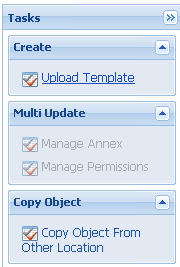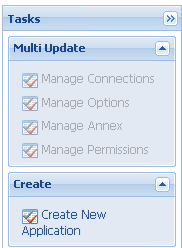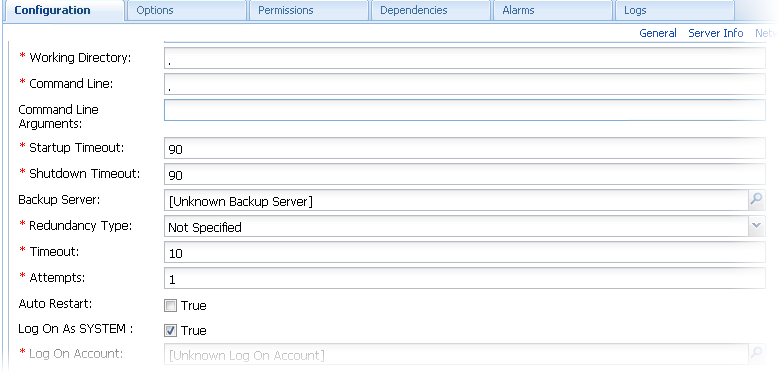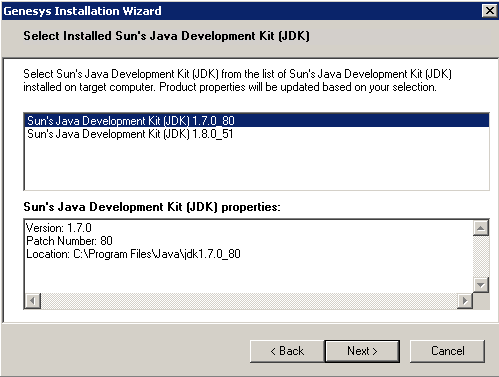Genesys Data Processing Server Deployment Guide
Genesys Data Processing Server (GDPS) processes the complex, high-volume data produced by select Genesys products for a variety of uses.
The following instructions describe how to install GDPS.
- Genesys recommends that you use a dedicated Cassandra data center. This will minimize the risk of Cassandra-related faults in operational environments.
Before you begin
Because GDPS must process a lot of data, it needs to run on top of a high-speed—and highly scalable—cluster computing system. Genesys uses Apache Spark for this task.
Spark supports several types of clustering. GDPS works well with the simplest one, Spark Standalone Mode. This mode provides high availability by using a dedicated master node. A typical cluster deployment will consist of one master node and several worker nodes and is usually started by GDPS in the background.
Genesys recommends that you configure GDPS in Genesys Administrator, defining a single Application Cluster object and the appropriate number of individual node objects. You can configure these objects and their options using the procedures provided on the rest of this page.
GDPS nodes
The Spark cluster consists of one master node and several worker nodes. Any GDPS node can be the master node in the cluster, as this role is defined by the value of the Spark startMode option in the node's configuration options. Here is more information about the two types of node:
- The Master node is represented by a Spark startMode of both, which indicates that both a Spark Master and a Spark Worker instance will be started on the node. Please note that the Spark host option should be set in agreement with startMode so that the hostname used in the Spark host setting belongs to the node that runs the Spark Master instance. To avoid problems with connectivity inside the Spark cluster, this hostname should be the primary one in the network configuration for this host. In other words, Java's InetAddress.getLocalHost should return the same value for the GDPS Master node.
- The Worker node is represented by a startMode of worker. Only a Spark worker instance will be launched at this node.
There is one additional mode available for the Spark startMode option. A mode of off means that no Spark processes will be launched on this host and that the role of the node in the GDPS cluster is undefined. This mode is for use in situations where you want to have an externally managed Spark cluster, and limits you to one GDPS node, which serves as an entry point for the Spark cluster. You cannot deploy GDPS with multiple nodes if you have set startMode to off. Also, if you use this mode, you must have an advanced understanding of how to work with and manage a Spark cluster.
Configuring GDPS
We have included information about GDPS–related configuration options at the end of this page.
Deploying GDPS
To deploy GDPS, follow these steps:
- Importing the GDPS cluster template
- Creating the cluster application
- Configuring the cluster application
- Importing the GDPS template
- Creating a node application
- Configuring a node application
- Adding nodes to a cluster
- Updating the UCS cluster application
- GDPS data storage
- Installing GDPS
Note: For more information on how to work with templates and application objects in Genesys Administrator, consult Generic Configuration Procedures.
Importing the GDPS cluster template
Note: For more information on how to work with templates in Genesys Administrator, consult Generic Configuration Procedures.
Start
- Open Genesys Administrator and navigate to Provisioning > Environment > Application Templates.
- In the Tasks panel, click Upload Template.
- In the Click 'Add' and choose application template (APD) file to import window, click Add.
- Browse to the Data_Processing_Cluster.apd file. The New Application Template panel opens.
- Click Save & Close.
End
Creating the cluster application
Note: For more information on how to work with application objects in Genesys Administrator, consult Generic Configuration Procedures.
Prerequisites
- You have completed Importing the GDPS cluster template.
Start
- Open Genesys Administrator and navigate to Provisioning > Environment > Applications.
- In the Tasks panel, click Create New Application.
- In the Select Application Template panel, click Browse for Template and select the GDPS cluster template that you imported in Importing the GDPS cluster template. Click OK.
- The template is added to the Select Application Template panel. Click Next.
- In the Select Metadata file panel, click Browse and select the Data_Processing_Cluster.xml file. Click Open.
- The metadata file is added to the Select Metadata file panel. Click Next.
- In the Specify Application parameters tab:
- Enter a name for your application. For instance, Data_Processing_Server_Cluster.
- Make sure State is enabled.
- Select the Host on which the GDPS cluster will reside.
- Click Create.
- The Results panel opens.
- Enable Opens the Application details form after clicking 'Finish' and click Finish. The GDPS cluster application form opens and you can start configuring the GDPS cluster application.
End
Configuring the cluster application
Note: For more information on how to work with application objects in Genesys Administrator, consult Generic Configuration Procedures.
Prerequisites
- You completed Creating the cluster application.
Start
- If your Cluster application form is not open in Genesys Administrator, navigate to Provisioning > Environment > Applications. Select the application defined for the GDPS cluster and click Edit....
- Expand the Server Info pane.
- If your Host is not defined, click the lookup icon to browse to the hostname of your application.
- Ensure the Working Directory and Command Line fields contain "." (period).
- Click Save.
- In the Listening Ports section, create the default port by clicking Add. The Port Info dialog opens.
- Enter the Port. For instance, 10081.
- Choose http for the Connection Protocol.
- Click OK. The HTTP port with the default identifier appears in the list of Listening ports.
- Genesys recommends that you use external Cassandra and that you configure the GDPS cluster option in a similar way to the UCS cluster options.
GDPS supports the same Cassandra security features as UCS, with the exception of mutual TLS. Use the Cassandra security article for guidance on setting up Cassandra security for GDPS.
End
Importing the GDPS template
Prerequisites
- You completed Configuring the cluster application.
Start
- Open Genesys Administrator and navigate to Provisioning > Environment > Application Templates.
- In the Tasks panel, click Upload Template.
- In the Click 'Add' and choose application template (APD) file to import window, click Add.
- Browse to the Data_Processing_Server.apd file and select it. The New Application Template panel opens.
- Click Save & Close.
End
Creating a node application
Prerequisites
- You completed Importing the GDPS template.
Start
- Open Genesys Administrator and navigate to Provisioning > Environment > Applications.
- In the Tasks panel, click Create New Application.
- In the Select Application Template panel, click Browse for Template and select the GDPS template that you imported in Importing the GDPS template. Click OK.
- The template is added to the Select Application Template panel. Click Next.
- In the Select Metadata file panel, click Browse and select the Data_Processing_Server.xml file. Click Open.
- The metadata file is added to the Select Metadata file panel. Click Next.
- In Specify Application parameters:
- Enter a name for your application. For instance, Data_Processing_Server.
- Make sure State is enabled.
- Select the Host on which the node will reside.
- Click Create.
- The Results panel opens.
- Click Save & Close. If the Confirmation dialog opens, click Yes.
- Enable Opens the Application details form after clicking 'Finish' and click Finish. The Data_Processing_Server application form opens and you can start configuring the node application.
End
Configuring a node application
Prerequisites
- You completed Creating a node application.
Start
- If your node application form is not open in Genesys Administrator, navigate to Provisioning > Environment > Applications. Select the application defined for the node and click Edit....
- In the Connections section of the Configuration tab, click Add. The Browse for applications panel opens. Select the GDPS cluster application you defined above, then click OK.
- Expand the Server Info pane.
- If your Host is not defined, click the lookup icon to browse to the hostname of your application.
- In the Listening Ports section, create the default port by clicking Add. The Port Info dialog opens.
- Enter the Port. For instance, 10081.
- Choose http for the Connection Protocol.
- Click OK. The HTTP port with the default identifier appears in the list of Listening ports.
- Click Save.
- Genesys recommends that you use external Cassandra and that you configure the GDPS application options in a similar way to the UCS options.
End
Adding nodes to a cluster
To create more nodes:
Start
- Follow the instructions above for Creating a node application, but use a different name for the new node.
- Configure the new node application, as shown above, but point to a different port.
End
Storage configuration
GDPS also stores its packages (execution logic) in the Cassandra database, but some configuration is required because the default setup will not work.
For external Cassandra, modify the commitlog_segment_size_in_mb configuration option in the conf/cassandra.yaml file on all Cassandra nodes to have a value not less than 64.
Installing GDPS
Install the GDPS on Windows or Linux.
Note: For more information on how to install apps that you have configured in Genesys Administrator, consult Generic Installation Procedures.
Prerequisites
- Configuring a node application
- A supported JDK is installed.
- In your installation package, locate and double-click the setup.exe file. The Install Shield opens the welcome screen.
- Click Next. The Connection Parameters to the Configuration Server screen appears.
- Under Host, specify the host name and port number where Configuration Server is running. (This is the main "listening" port entered in the Server Info tab for Configuration Server.)
- Under User, enter the user name and password for logging on to Configuration Server.
- Click Next. The Select Application screen appears.
- Select the GDPS Application—that is, the Node app you created above—that you are installing. The Application Properties area shows the Type, Host, Working Directory, Command Line executable, and Command Line Arguments information previously entered in the Server Info and Start Info tabs of the selected Application object.
Note: For multi-node clusters, you must install the GDPS Application into exactly the same directory on every node. For example, if the path for Node 1 is /genesys/gdps/gdps_n1, it cannot be /genesys/gdps/gdps_n2 for any of the other nodes. This requires manual intervention, since the installation package offers a default installation path based on the application name, which is therefore different for each node. - Click Next. The Choose Destination Location screen appears.
- Under Destination Folder, keep the default value or browse for the desired installation location. Note that you probably do not want to use the Windows Program Files folder as your destination folder.
- Click Next. The Backup Configuration Server Parameters screen appears.
- If you have a backup Configuration Server, enter the Host name and Port.
- In the Pulse Collector Configuration window, ensure that Use Pulse Collector is unchecked:
- Click Next. Select the appropriate JDK:
- Click Next. The Ready to Install screen appears.
- Click Install. The Genesys Installation Wizard indicates it is performing the requested operation for GDPS. When through, the Installation Complete screen appears.
- Click Finish to complete your installation of the GDPS.
- Inspect the directory tree of your system to make sure that the files have been installed in the location that you intended.
- The Spark temporary directory. You can find it in the system temporary directory with a name template of spark-*. The default location for this directory is system_disk:\Users\user_name\AppData\Local\Temp directory. You can also use the system disk clean-up procedure.
- Within the GDPS directory itself, the <GDPS directory>/spark/work folder.
Prerequisites
- Configuring a node application
- A supported JDK is installed.
- Open the GDPS IP, and run the install.sh file. The Genesys Installation starts.
- Enter the hostname of the host on which you are going to install.
- Enter the connection information to log in to Configuration Server:
- The hostname. For instance, demosrv.genesyslab.com.
- The listening port. For instance, 2020.
- The user name. For instance, demo.
- The password.
- If you have a backup Configuration Server, enter the Host name and Port.
If the connection settings are successful, a list of keys and applications is displayed. - Enter the key for the GDPS application—that is, the Node app you created above in Configuration Server.
- Use the key for Genesys Pulse to disable the Pulse Collector
- Enter the location where GDPS is to be installed on your server.
Note: This location must match the previous settings that you entered in Configuration Server.
Note: For multi-node clusters, you must install the GDPS Application into exactly the same directory on every node. For example, if the path for Node 1 is /genesys/gdps/gdps_n1, it cannot be /genesys/gdps/gdps_n2 for any of the other nodes. This requires manual intervention, since the installation package offers a default installation path based on the application name, which is therefore different for each node. - If the installation is successful, the console displays the following message:
Installation of Genesys GDPS, version 8.5.x has completed successfully. - Inspect the directory tree of your system to make sure that the files have been installed in the location that you intended.
Note: Genesys recommends that you regularly clear the following:
- The Spark temporary directory. You can find it in the system temporary directory with a name template of spark-*. The default location for this directory will be the /tmp folder of the user running the GDPS host (something like /<user>/tmp).
- Within the GDPS directory itself, the <GDPS directory>/spark/work folder.
Configuration options
The following configuration options can be useful in setting up GDPS and your Spark cluster.
[log] Section options
The [log] section configuration options are applied to the GDPS environment in a way that is similar to how they are used with UCS. UCS log options are documented here.
[cassandraKeyspace] Section options
GDPS stores some of its data (packages and schedule) in a dedicated Cassandra keyspace. The [cassandraKeyspace] section provides its configuration options. All of the options mean pretty much the same as they do when used with UCS although some of their values—such as for the name—will be different.
spark Options
GDPS launches a dedicated Spark cluster and all of the GDPS nodes need to share the coordinates of the Spark Master node. In addition to this, each individual node has options that can be used to configure the mode with which Spark starts on its box. Default values should be sufficient in most circumstances.
host
Description: The name of the Spark Master host. The value should be the same as what Java's InetAddress.getLocalHost() would return for the specified host.
Default Value: None
Valid Values: hostname of the Spark Master node
Mandatory: No
Changes Take Effect: After start/restart
port
Description: The port number of the Spark Master host.
Default Value: 7077
Valid Values: Valid port number
Mandatory: No
Changes Take Effect: After start/restart
startMode
Description: The mode that will be used when starting Spark. If set to off, Spark will not be started by GDPS, and will instead have its state managed externally. If set to worker, only a worker node will be started. If set to both, both a worker node and a master node are started. Note: Genesys recommends that you set this option for each node to clearly specify the role. However, you can set the Cluster object to worker mode and override that value for the master node by setting that node to both.
Default Value: worker
Valid Values: off, worker, or both
Mandatory: No
Changes Take Effect: After start/restart
masterWebPort
Description: The number of the TCP port that the Spark Master web UI will listen on. Note that this option is provided for cases when the default port has already been used by another service.
Default Value: 8080
Valid Values: Valid port number
Mandatory: No
Changes Take Effect: After start/restart
workerWebPort
Description: The number of the TCP port that the Spark Worker web UI will listen on. Note that this option is provided for cases when the default port has already been used by another service.
Default Value: 8081
Valid Values: Valid port number
Mandatory: No
Changes Take Effect: After start/restart
executorMemory
Description: Use this option to manage the amount of memory used by Spark for executing tasks on each node. Genesys recommends at least two gigabytes per node, but more memory can improve performance if hardware allows. For information about the format, consult the Spark documentation.
Default Value: None
Valid Values: Valid memory limit
Mandatory: No
Changes Take Effect: After start/restart
sparkHeartbeatTimeout
Description: The timeout value in seconds between two heartbeat calls to the Spark metrics API.
Default Value: 60
Valid Values: Positive integer
Mandatory: No
Changes Take Effect: After start/restart
sparkStartTimeout
Description: The timeout value in seconds between a Spark start or restart and the first time its API is checked. On slower machines, it makes sense to increase this value so that Spark has enough time to start successfully (without initiating a restart cycle).
Default Value: 20
Valid Values: Positive integer
Mandatory: No
Changes Take Effect: After start/restart
uri
Description: Advanced. For situations when Spark is running externally, you must set the URI instead of the host and port. The URI must include the protocol, in addition to the host and port.
Default Value: None
Valid Values: Valid Spark URI
Mandatory: No
Changes Take Effect: After start/restart
spark.context
Advanced. This entire section is copied into SparkContext, so it can be used to tune the Spark options. You must have an in-depth understanding of Spark configuration if you are going to use this section.
To enable GDPS to handle dates in UTC format, the following option, set the value of spark.executor.extraJavaOptions to:
-Duser.timezone=UTC






